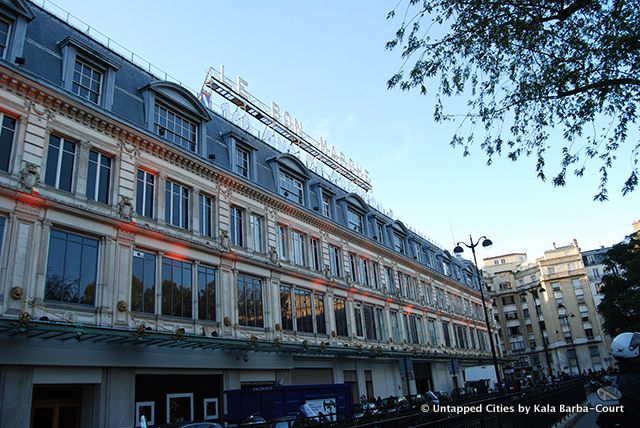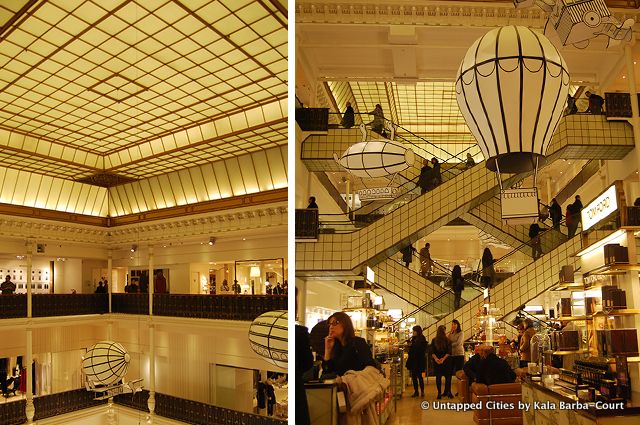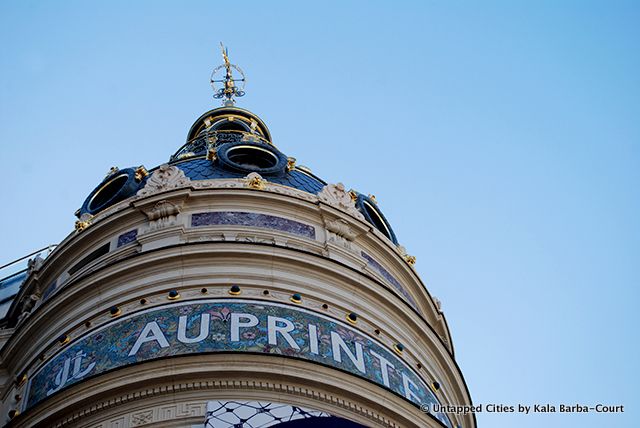See the New Times Square New Year's Eve Ball Up Close
Find out how you can take home a piece of the old New Year's Eve ball!


Along with the dizzying number of museums and monuments in Paris, a tour of the Grands Magasins (literally, big stores or department stores) merits a place in the list of things to do and see in the city. You may wonder why these huge, block-long department stores are such a big deal – they are, after all, just stores, and Paris has millions of them, you may say. But beneath their grandeur and breathtaking architecture lies a history that revolutionized the art of retail.
LE BON MARCHÉ
24 Rue de Sèvres, 75007 Paris
Metro: Sèvres-Babylone
Shopping was difficult in the 19th century. Specialized shops meant that one had to go door to door to find specific products, and when these items were found, customers would have to haggle for a price, as the wares remained without fixed prices.
Aristide Baucicaut, an ambitious sales clerk working at a small shop called Petit St. Thomas, teamed up with entrepreneur Paul Videau, owner of Au Bon Marché at the corner of rue de Bac and rue de Sevres in the Left Bank. Baucicaut turned the business around by ordering small batches of stock items at a time and selling them at a low price, which made the turnover fast and efficient.

As their benefits went from 450,000 francs to 7 million francs, Videau sold his part to Boucicaut in 1863, making the latter the sole proprietor of what we know now as Le Bon Marché. Terrain was bought and the store expanded. Louis-Charles Boileau and Gustave Eiffel contributed to the architecture of steel and glass that it is today.

Le Bon Marché was ahead of its time. Stocked with every imaginable product one could ever want or need, it set the standards for the other grands magasins that were to appear years later. Baucicaut introduced many new concepts: seasonal collections, free deliveries, product catalogues, reimbursable items. It opened its doors to the middle class, its target clientele. Workers enjoyed benefits such as commissions on items they sold, retirement pay, health insurance, and store discounts. It was so successful that Emile Zola patterned the fictional shopping center in his novel “Au Bonheur des Dames” after Le Bon Marché.
Artistide Baucicaut died in 1877. In 25 years he had transformed a small 12-person business into a shopping emporium of 1,788 employees. In 1910, his widow built the art deco-inspired Hotel Lutetia along boulevard Raspail to accommodate clients traveling to Paris to shop at Le Bon Marché, and which later became a popular hangout for the Left Bank intellectual circle.
Le Bon Marché was bought by the LVMH group in 1984. You can visit Le Bon Marché’s La Grande Epicerie, which boasts culinary products from all over the world.
PRINTEMPS
64, blvd Haussmann, 75009 Paris
Metro: Havre Caumartin
RER A: Auber, RER E: Haussmann St-Lazare
The new standards for retail shopping had been set, and it was inevitable that competition would soon show up. In 1865, Printemps was created by Jules Jaluzot, a former employee of Le Bon Marché. He chose to establish his grand magasin in the then-developing quarter of Saint-Lazare, not far from where he lived. The building, at the corner of rue du Havre and Boulevard Haussman, was built by architects Jules and Paul Sédille. It expanded into four more buildings by 1874.
The store introduced ‘les soldes’, selling items from past collections at lower prices. They displayed the latest fashion with mannequins on their storefront windows, and even offered bouquets of violets to clients on the first day of spring.
Although the second of the grands magasins in Paris, Printemps had a lot of firsts to offer: it was the first to using electric lighting in 1888, and the first store to be directly connected to the metro.
Printemps in the early 20th century was known for its Art Nouveau facade, its grand 42-meter high domed hall, a huge spiral staircase, and floral-inspired mosaic tiles. It has, however, undergone major reconstructions twice after the fires that broke out in 1881 and 1921.

Today, the Art Nouveau staircase is long gone, but with its dominating cupola and impressive facade that earned Printemps a place in the list of Historic Monuments, it still stays at the height of its glory.
GALERIES LAFAYETTE
40, blvd Haussmann, 75009 PARIS
Metro: Chaussée d’Antin, Opéra, Trinité
RER A: Auber, RER E: Haussmann St-Lazare
The Opéra area had become a busy shopping district in 1894, and it made perfect sense for cousins Alphonse Kahn and Théophile Bader to build their own store in a 70m2 space at the corner of rue La Fayette and rue de la Chaussée d’Antin. Baptised Galeries Lafayette, it became an instant hit and as expected, they expanded their territory, buying the entire building of 1 rue La Fayette at first and then buildings 38,40 and 42 along boulevard Haussmann.
Architects Georges Chedanne and Ferdinand Chanut created the vision Théophile Bader had for his grand magasin: a shopping destination for high fashion and luxury items. In 1912, its sprawling staircases, Art Nouveau balconies, and glittering dome were revealed to the public – a 5-storey mecca for the latest modes and fashion. It wasn’t only the clothes for sale that were on display. The architects of the grands magasins purposefully built them so shoppers could see and be seen.
Bader made sure to stay on top of the fashion scene by producing and selling clothes exclusively under the mark Galeries Lafayette. He would walk along Opéra with a designer, where they would scope out and sketch the latest street fashion, which they would later tweak and adapt for their own branding. It was a huge success, yet they would later branch out and offer other products such as home decor and men’s collections.
Unlike its predecessors, Galeries Lafayette has managed to keep the business in the family for the last five generations. They were able to ride through the storms of war, economic crises and ever-changing demands of the clients, proving that fashion, indeed, knows no limits.
This is the first of a two-part article tackling the history of the Grands Magasins of Paris. Stay tuned for Part Two, where we revisit the roots of La Samaritaine and BHV.
Subscribe to our newsletter